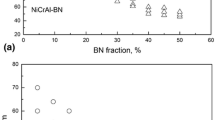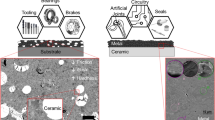Abstract
During the cold spraying of particle-reinforced metal matrix composite coatings (ceramic and metal particles mixture) on metal substrates, ceramic particles may either get embedded in the substrate/deposited coating or may rebound from the substrate surface. In this study, the dependence of the ceramic rebounding phenomenon on the spray angle and its effect on substrate erosion have been analyzed using finite-element analysis. From the numerical simulations, it was found that the ceramic particle density and substrate material strength played the major roles in determining the embedding and ceramic retention behavior. Substrate material erosion also influenced the ceramic retention, and the material loss increased as the impact angles decreased from normal. In general, the results concluded that decreasing the impact angle promoted the retention possibility of ceramics in the substrate. This study provides new theoretical insights into the effect of spray angles on the ceramic retention and suggests a new route toward optimizing the spraying process to increase the ceramic retention in composite coatings cold spray.








Similar content being viewed by others
References
A. Papyrin et al., Cold Spray Technology, Elsevier, Amsterdam, 2006
R.G. Maev and V. Leshchynsky, Introduction to Low Pressure Gas Dynamic Spray: Physics & Technology, Wiley-VCH, Weinheim, Germany, 2008
E. Irissou et al., Investigation of Al-Al2O3 Cold Spray Coating Formation and Properties, J. Therm. Spray Technol., 2007, 16(5–6), p 661-668
S.V. Klinkov et al., Deposition of Multicomponent Coatings by Cold Spray, Surf. Coat. Technol., 2008, 202(24), p 5858-5862
A. Moridi et al., Cold Spray Coating: Review of Material Systems and Future Perspectives, Surf. Eng., 2014, 30(6), p 369-395
J. Villafuerte, Modern Cold Spray, Springer International Publishing, Switzerland, 2015
V.K. Champagne, The Cold Spray Materials Deposition Process: Fundamentals and Applications, Elsevier, Amsterdam, 2007
J. Shockley et al., The Influence of Al2O3 Particle Morphology on the Coating Formation and Dry Sliding Wear Behavior of Cold Sprayed Al-Al2O3 Composites, Surf. Coat. Technol., 2015, 270, p 324-333
A. Sova et al., Effect of Ceramic Particle Velocity on Cold Spray Deposition of Metal-Ceramic Coatings, J. Therm. Spray Technol., 2010, 20(1–2), p 285-291
H. Assadi et al., Bonding Mechanism in Cold Gas Spraying, Acta Mater., 2003, 51(15), p 4379-4394
G. Bae et al., General Aspects of Interface Bonding in Kinetic Sprayed Coatings, Acta Mater., 2008, 56(17), p 4858-4868
M. Grujicic et al., Adiabatic Shear Instability Based Mechanism for Particles/Substrate Bonding in the Cold-Gas Dynamic-Spray Process, Mater. Des., 2004, 25(8), p 681-688
T. Hussain et al., Bonding Mechanisms in Cold Spraying: The Contributions of Metallurgical and Mechanical Components, J. Therm. Spray Technol., 2009, 18(3), p 364-379
N.M. Melendez and A.G. McDonald, Development of WC-Based Metal Matrix Composite Coatings Using Low-Pressure Cold Gas Dynamic Spraying, Surf. Coat. Technol., 2013, 214, p 101-109
H. Getu, J.K. Spelt, and M. Papini, Conditions Leading to the Embedding of Angular and Spherical Particles During the Solid Particle Erosion of Polymers, Wear, 2012, 292–293, p 159-168
C. Li, et al. Effect of Spray Angle on Deposition Characteristics in Cold Spraying. Thermal Spray 2003 Adv. Sci. Appl. Technol. 2003.
W.-Y. Li, S. Yin, and X.-F. Wang, Numerical Investigations of the Effect of Oblique Impact on Particle Deformation in Cold Spraying by the SPH Method, Appl. Surf. Sci., 2010, 256(12), p 3725-3734
D. Simulia, ABAQUS 6.11 Analysis User’s Manual. Abaqus, 2011. 6: p. 22.2
H. Assadi, T. Klassen, and F. Gartner, Modelling of Impact and Bonding of Inhomogeneous Particles in Cold Spraying, in International Thermal Spray Conf., Barcelona, 2014
Y.I. Oka et al., Damage Behaviour of Metallic Materials Caused by Subsonic to Hypervelocity Particle Impact, Wear, 2005, 258(1–4), p 100-106
S. Yin et al., Examination on the Calculation Method for Modeling the Multi-Particle Impact Process in Cold Spraying, J. Therm. Spray Technol., 2010, 19(5), p 1032-1041
M. Yu et al., Finite Element Simulation of Impacting Behavior of Particles in Cold Spraying by Eulerian Approach, J. Therm. Spray Technol., 2012, 21(3–4), p 745-752
S. Yin et al., Effect of Substrate Hardness on the Deformation Behavior of Subsequently Incident Particles in Cold Spraying, Appl. Surf. Sci., 2011, 257(17), p 7560-7565
J. Xie, Simulation of Cold Spray Particle Deposition Process. 2014, INSA de Lyon
B. Bhushan, Introduction to Tribology, Wiley, New York, 2013
www.matweb.com. (cited 2017 February 20th)
A. Manap et al., Experimental and SPH Study of Cold Spray Impact Between Similar and Dissimilar Metals, Surf. Eng., 2014, 30(5), p 335-341
G.R. Johnson and W.H. Cook, A Constitutive Model and Data for Metals Subjected to Large Strains, High Strain Rates and High Temperatures, in Proceedings of the 7th International Symposium on Ballistics. 1983. The Hague, The Netherlands
G.R. Johnson and W.H. Cook, Fracture Characteristics of Three Metals Subjected to Various Strains, Strain Rates, Temperatures and Pressures, Eng. Fract. Mech., 1985, 21(1), p 31-48
B. Jodoin et al., Effect of Particle Size, Morphology, Hardness on Cold Gas Dynamic Sprayed Aluminum Alloy Coatings, Surf. Coat. Technol., 2006, 201(6), p 3422-3429
Y.I. Oka and K. Nagahashi, Measurements of Plastic Strain Around Indentations Caused by the Impact of Round and Angular Particles, and the Origin of Erosion, Wear, 2003, 254(12), p 1267-1275
M. Takaffoli and M. Papini, Material Deformation and Removal Due to Single Particle Impacts on Ductile Materials Using Smoothed Particle Hydrodynamics, Wear, 2012, 274–275, p 50-59
Y. Isomoto et al., Damage Behaviour of Target Materials Caused by Subsonic to Hypervelocity Particle Impact, Zair. Kankyo Corros.Eng., 2003, 52(7), p 371-377
Z.G. Liu et al., A Numerical Study on the Effect of Particle Shape on the Erosion of Ductile Materials, Wear, 2014, 313(1–2), p 135-142
Y.-F. Wang and Z.-G. Yang, Finite Element Model of Erosive Wear on Ductile and Brittle Materials, Wear, 2008, 265(5–6), p 871-878
Y.I. Oka et al., The Impact Angle Dependence of Erosion Damage Caused by Solid Particle Impact, Wear, 1997, 203–204, p 573-579
Acknowledgments
We greatly thank the financial support from McGill Engineering Doctoral Award and National Sciences and Engineering Research Council (NSERC) of Canada. We also acknowledge Supercomputer Consortium Laval UQAM McGill and Eastern Quebec for providing computing power.
Author information
Authors and Affiliations
Corresponding author
Electronic supplementary material
Below is the link to the electronic supplementary material.
Rights and permissions
About this article
Cite this article
Chakrabarty, R., Song, J. Effect of Impact Angle on Ceramic Deposition Behavior in Composite Cold Spray: A Finite-Element Study. J Therm Spray Tech 26, 1434–1444 (2017). https://doi.org/10.1007/s11666-017-0604-z
Received:
Revised:
Published:
Issue Date:
DOI: https://doi.org/10.1007/s11666-017-0604-z




